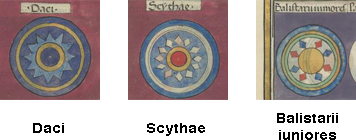
This page created 6 April 2014, and last modified: 12 September 2015 (Aurelius Gaius picture and commentary updated)

In the eastern half of the empire, the third of the six units of legiones palatina under the command of the second Master of the Soldiers in the Imperial Presence, the Magister Militum Praesentalis II, is listed (12.18 in Ingo Maier's numbering scheme) as the Scythae. Its shield pattern (10#4) as shown in various manuscripts, under the same label (10.d), is as below:

The shield patten features a blue rim, a yellow inner band inwards from the rim, a blue main field (purple in B), and a red boss encircled with another yellow band. Radiating from this band are 12 (O, P) white rhombuses (but 14 in B, W; and 18 in M). The pattern is somewhat (but not closely) similar to those of two other units: that of the Daci, the immediately preceding (12.17) unit under the same command, and the Balistarii iuniores, listed (18.25) under the Magister Militum per Thracias; you can see their patterns as taken from the Paris manuscript (P) below for comparison:

Either of these units could support a "relationship" with the Scythae: the Daci as an habitually-brigaded unit, and the Balistarii iuniores as previously brigaded unit or else a permanent detachment of the old legion's artillery. Perhaps both could be supported; but since the patterns are not really that close, they may both just be coincidentally similar.
The Scythae itself may well derive from Legio IIII Scythica, founded by Marcus Antonius in the dying years of the Republic, and which was long stationed at Zeugma in Commagene on the Euphrates (now partially under the waters behind the Birecik Dam in Turkey); Legio IIII Scythica itself appears in the Notitia (65.9) under the Dux Syriae et Eufratensis Syriae, although its station is given as "Oresa" and not Zeugma.
However, the names Scythae and Daci, being the names of neighbouring provinces, suggest an alternative derivation. Epigraphic evidence (e.g. AE 1944,0068, a tile from modern Garvan in Romania, bearing the legend LEGIO I IOVIAE SCY; and see also "The Tetrarchic Reorganization of the Limes Scythicus, Mihail Zahariade; The Lower Danube in Antiquity", International Archaeological Conference, Bulgaria-Tutrakan 6-7.10.2005; Bulgarian Academy of Sciences, National Institute of Archaeology and Museum, Sofia, 2006; p 1-12, available here) shows that Legio I Iovia under the command (74.22-25) of the Dux Scythiae was called more properly Legio I Iovia Scythica, and thus might instead be the progenitor of the Scythae. If this interpretation is correct, the Daci might well then likely derive from a neighbouring unit stationed in Dacia, under the Dux Daciae ripensis, perhaps Legio V Macedonica (80.20-22,28) or Legio XIII Gemina (80.23-27).
|
A derivation from Legio I Iovia Scythica is strengthened by the grave stele of Aurelius Gaius found in Cotyaeum (modern Kutahya in Turkey), and dated to the Tetrarchy. The inscription (in Greek; SEG 31:1116 = AE 1981, 777) implies most of his exceptionally well-travelled career was with Legio I Iovia Scythica (see Peter Kocacs, A Phrygian Soldier in Pannonia - Some Notes on the Stela SEG 31, 1116 (2008), available here), while the stele's accompanying portrait shows him bearing a shield that is reasonably close to that of the Notitia's Scythae, despite dating a hundred years before:
Gaius' shield is round (see right: image used with kind permission of Peter Kocacs), as is commonly seen with men who are identified as lanciarii, and has concentric rings as does that of the Scythae, but it must be conceded that this is hardly unusual for legionary shield patterns - nearly half of the Notitia's legionary patterns can be said to have such a layout. More important is the decoration in the middle band, which, although hard to see in the picture, appears to be somewhat petal-like or at least radiate (as noticed by M.P. Speidel in Roman Army Studies II, Stuttgart, 1992, 414-418, at note 31), and thus is much less typical for legionary shields patterns in the Notitia. |

|
Looking beyond the time of the Notitia's compilation, the Scythae, like the Daci, was apparently stationed in Egypt, as two of the Oxyrhynchos papyri dated to the 6th century record the unit. One, P.Oxy.16.1920, dates from 563, while the other, P.Oxy.16.2046, dates from 564, both referring (at line 3, image here; and at line 4, image here, respectively) to the (in Greek) "stra[tiotais] ton Skython", i.e. the "soldiers of the Scythae".

Return to the Notitia alphabetical unit list page.
Return to my Notitia index page.